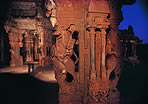| THEMES OF INTERPRETATION |
| The multi-dimensional documentation efforts of the Project have yielded an abundance of data that we are still studying. While our diverse analyses are by no means completed, over the years we have developed a number of interpretive themes to understand the archaeological record of the Vijayanagara site. At the largest scale, we have looked for order and meaning in the urban form of the city focusing on the ways that the city’s layout brought together the worlds of kings and gods. We have identified different functional zones and the axes that organize symbolic space. Rings of fortifications not only protected the urban population but also defined space and movement within the different zones of the city and between it and its hinterland. Roadways, which facilitated communication across the vast area of the site, also communicated meaning. Religious developments at the site were expressed in part through architecture and art. Scholars have studied the evolution of different cults and practices over more than 200 years. The growth of the city depended on secure supplies of water for agriculture, domestic use and even recreation. Team members have analysed a variety of systems for collecting, storing and moving water. Our colleagues have also studied ceramic technology, form and use. Intensive study of these fragmentary remains reveals insights into social and economic organization at the capital. Several scholars have examined techniques of stone technology. Some have discovered an industry for knapping and using stone implements. Others have examined the quarrying, shaping and assembly of granite building elements, identifying in one particular case the successive stages of construction. An astronomer working at Vijayanagara has carried out a pioneering archaeo-astronomical investigation in a bid to understand the alignments between sacred places and astronomical phenomena. Architectural style as it developed at the site has also attracted our attention, in particular the courtly buildings of the Royal Centre, which we interpret as manifestations of the cosmopolitan culture of Vijayanagara. Some of these buildings have been reconstructed using computer technology. Sculpture on the monuments of the city has been extensively documented; for an introduction to the subject link to Dallapiccola and verghese 1998, "An Appreciation of Vijayanagara Sculpture" and "Techniques, Styles and Forms". Many facilities were cut into granite bedrock by the inhabitants of the city ranging in use from food processing (mortars) to recreation (game boards). For a report on the latter link to Fritz and Gibson 2006, "Game Boards at Vijayanagara". |
||
| Top |
